Property Law Report: Rights and Ownership in Australian Property
VerifiedAdded on 2021/02/19
|10
|3308
|30
Report
AI Summary
This report provides a detailed analysis of Australian property law, specifically focusing on the concepts of joint tenancy and common tenancy. The report begins with an introduction to property law in Australia, highlighting the Real Property Act 1990. The main body of the report addresses a case study involving Mal and his three sons who purchased a property under joint tenancy, examining the legal implications of this arrangement, especially after the death of one of the sons. The report explores the legal definitions of joint tenancy and common tenancy, including the rights of survivorship and the 4 unities of joint tenancy. It further examines the validity of a conveyance deed and the implications of modifying contract terms. The application section analyzes the given case study, determining the legal binding effect of the joint tenancy clause and advising Mal on his rights concerning the property. The report concludes by summarizing the key findings and legal advice, referencing relevant case laws like In re Sorensen v. Sorensen and Williams v. Hensman. The report emphasizes the importance of understanding the differences between joint tenancy and common tenancy and their effects on property ownership and inheritance in New South Wales.
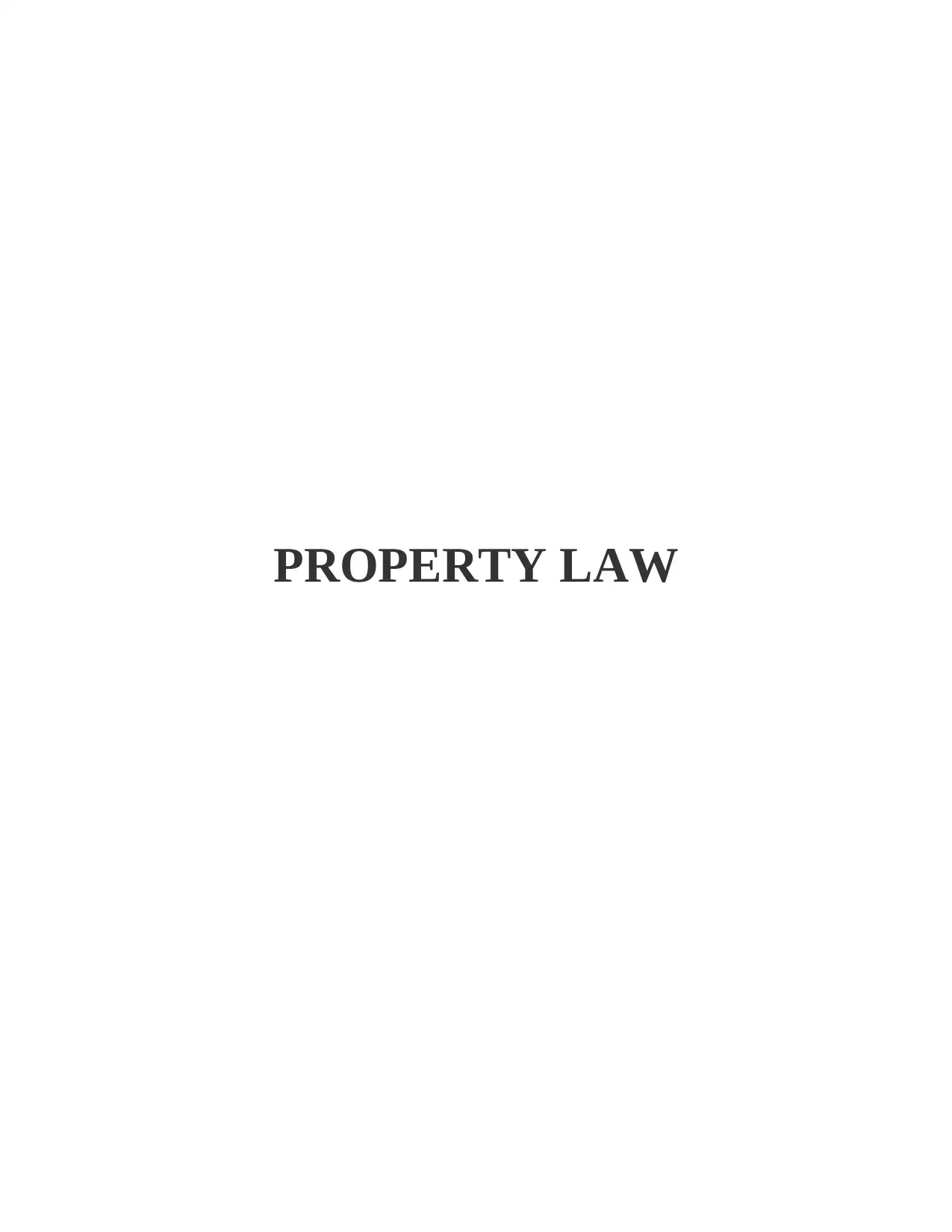
PROPERTY LAW
Paraphrase This Document
Need a fresh take? Get an instant paraphrase of this document with our AI Paraphraser
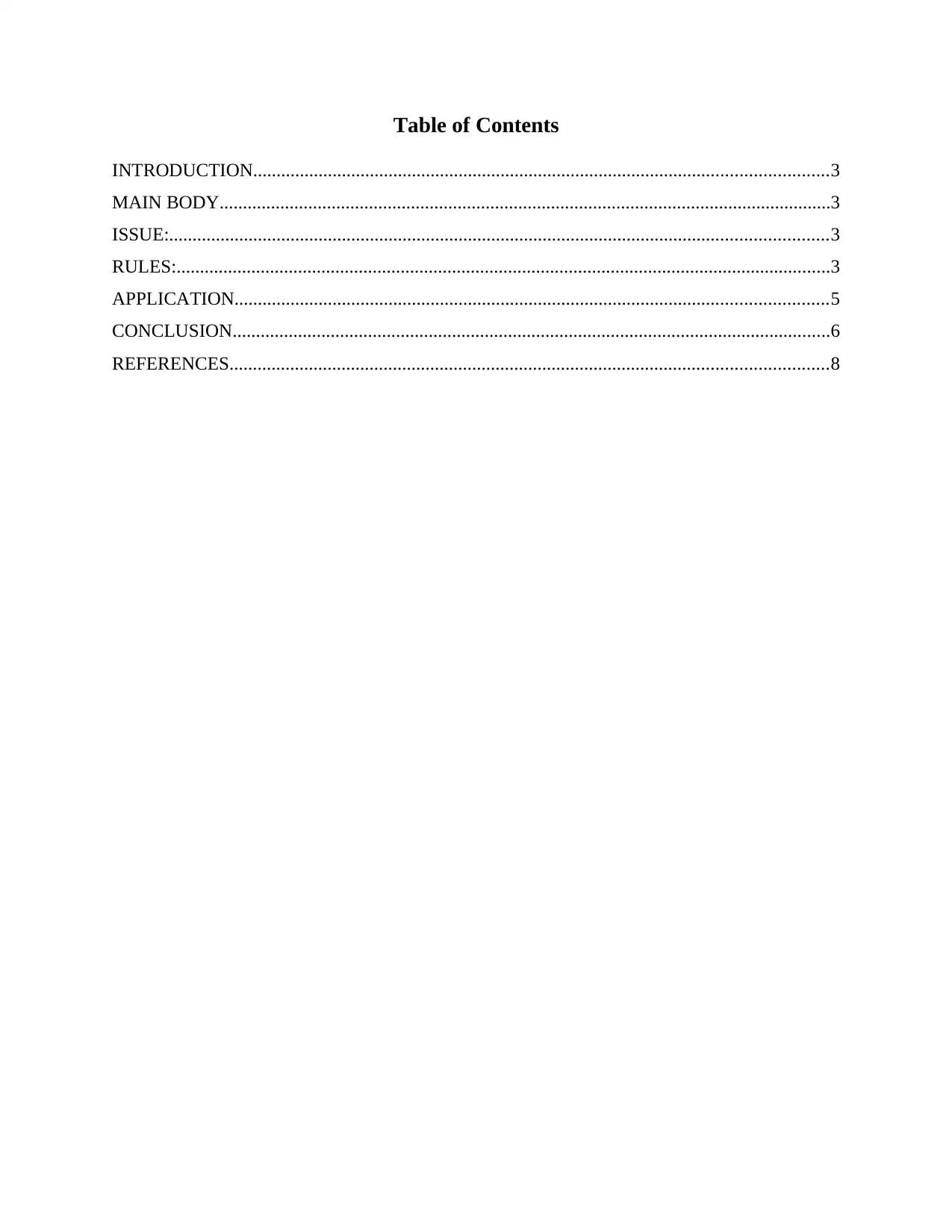
Table of Contents
INTRODUCTION...........................................................................................................................3
MAIN BODY...................................................................................................................................3
ISSUE:.............................................................................................................................................3
RULES:............................................................................................................................................3
APPLICATION...............................................................................................................................5
CONCLUSION................................................................................................................................6
REFERENCES................................................................................................................................8
INTRODUCTION...........................................................................................................................3
MAIN BODY...................................................................................................................................3
ISSUE:.............................................................................................................................................3
RULES:............................................................................................................................................3
APPLICATION...............................................................................................................................5
CONCLUSION................................................................................................................................6
REFERENCES................................................................................................................................8
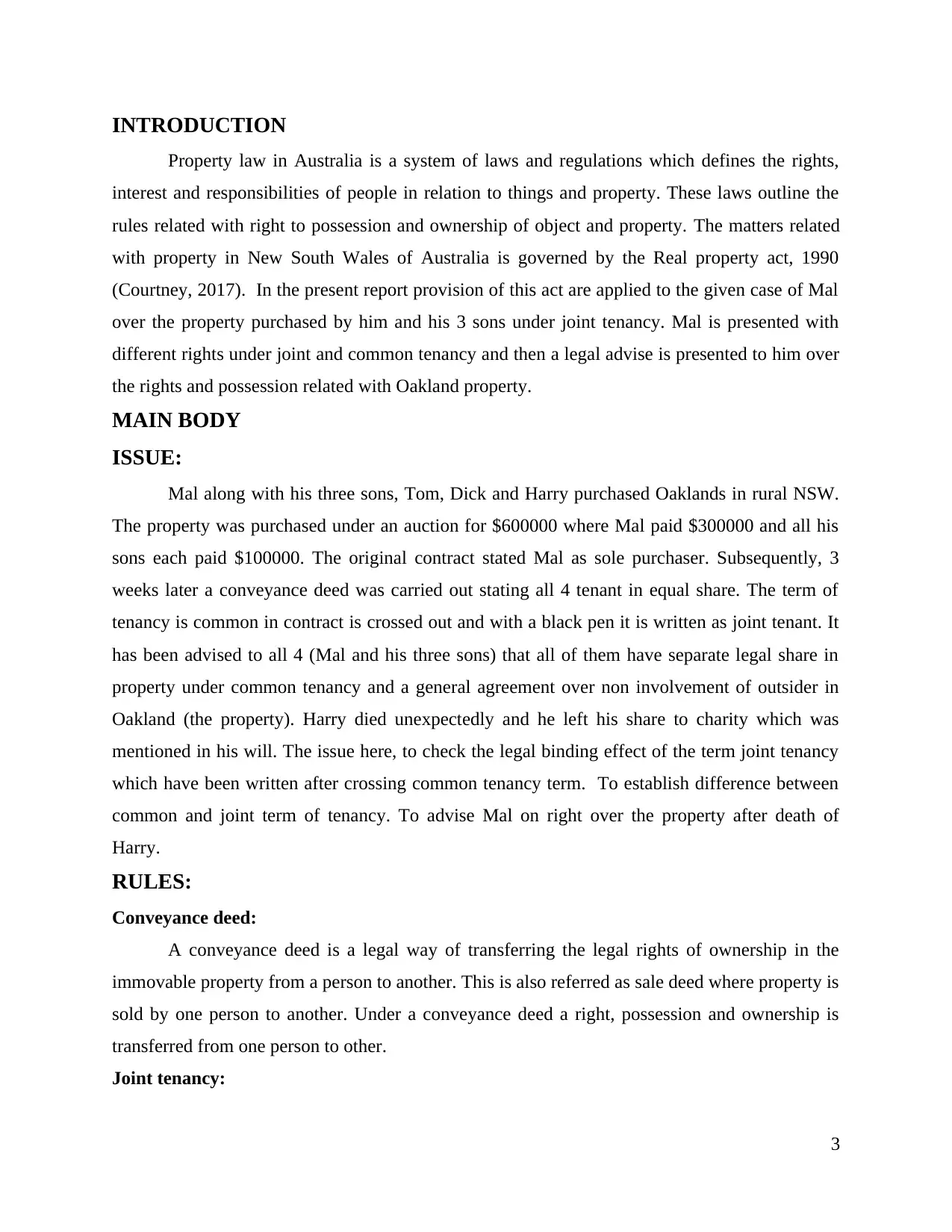
INTRODUCTION
Property law in Australia is a system of laws and regulations which defines the rights,
interest and responsibilities of people in relation to things and property. These laws outline the
rules related with right to possession and ownership of object and property. The matters related
with property in New South Wales of Australia is governed by the Real property act, 1990
(Courtney, 2017). In the present report provision of this act are applied to the given case of Mal
over the property purchased by him and his 3 sons under joint tenancy. Mal is presented with
different rights under joint and common tenancy and then a legal advise is presented to him over
the rights and possession related with Oakland property.
MAIN BODY
ISSUE:
Mal along with his three sons, Tom, Dick and Harry purchased Oaklands in rural NSW.
The property was purchased under an auction for $600000 where Mal paid $300000 and all his
sons each paid $100000. The original contract stated Mal as sole purchaser. Subsequently, 3
weeks later a conveyance deed was carried out stating all 4 tenant in equal share. The term of
tenancy is common in contract is crossed out and with a black pen it is written as joint tenant. It
has been advised to all 4 (Mal and his three sons) that all of them have separate legal share in
property under common tenancy and a general agreement over non involvement of outsider in
Oakland (the property). Harry died unexpectedly and he left his share to charity which was
mentioned in his will. The issue here, to check the legal binding effect of the term joint tenancy
which have been written after crossing common tenancy term. To establish difference between
common and joint term of tenancy. To advise Mal on right over the property after death of
Harry.
RULES:
Conveyance deed:
A conveyance deed is a legal way of transferring the legal rights of ownership in the
immovable property from a person to another. This is also referred as sale deed where property is
sold by one person to another. Under a conveyance deed a right, possession and ownership is
transferred from one person to other.
Joint tenancy:
3
Property law in Australia is a system of laws and regulations which defines the rights,
interest and responsibilities of people in relation to things and property. These laws outline the
rules related with right to possession and ownership of object and property. The matters related
with property in New South Wales of Australia is governed by the Real property act, 1990
(Courtney, 2017). In the present report provision of this act are applied to the given case of Mal
over the property purchased by him and his 3 sons under joint tenancy. Mal is presented with
different rights under joint and common tenancy and then a legal advise is presented to him over
the rights and possession related with Oakland property.
MAIN BODY
ISSUE:
Mal along with his three sons, Tom, Dick and Harry purchased Oaklands in rural NSW.
The property was purchased under an auction for $600000 where Mal paid $300000 and all his
sons each paid $100000. The original contract stated Mal as sole purchaser. Subsequently, 3
weeks later a conveyance deed was carried out stating all 4 tenant in equal share. The term of
tenancy is common in contract is crossed out and with a black pen it is written as joint tenant. It
has been advised to all 4 (Mal and his three sons) that all of them have separate legal share in
property under common tenancy and a general agreement over non involvement of outsider in
Oakland (the property). Harry died unexpectedly and he left his share to charity which was
mentioned in his will. The issue here, to check the legal binding effect of the term joint tenancy
which have been written after crossing common tenancy term. To establish difference between
common and joint term of tenancy. To advise Mal on right over the property after death of
Harry.
RULES:
Conveyance deed:
A conveyance deed is a legal way of transferring the legal rights of ownership in the
immovable property from a person to another. This is also referred as sale deed where property is
sold by one person to another. Under a conveyance deed a right, possession and ownership is
transferred from one person to other.
Joint tenancy:
3
⊘ This is a preview!⊘
Do you want full access?
Subscribe today to unlock all pages.

Trusted by 1+ million students worldwide
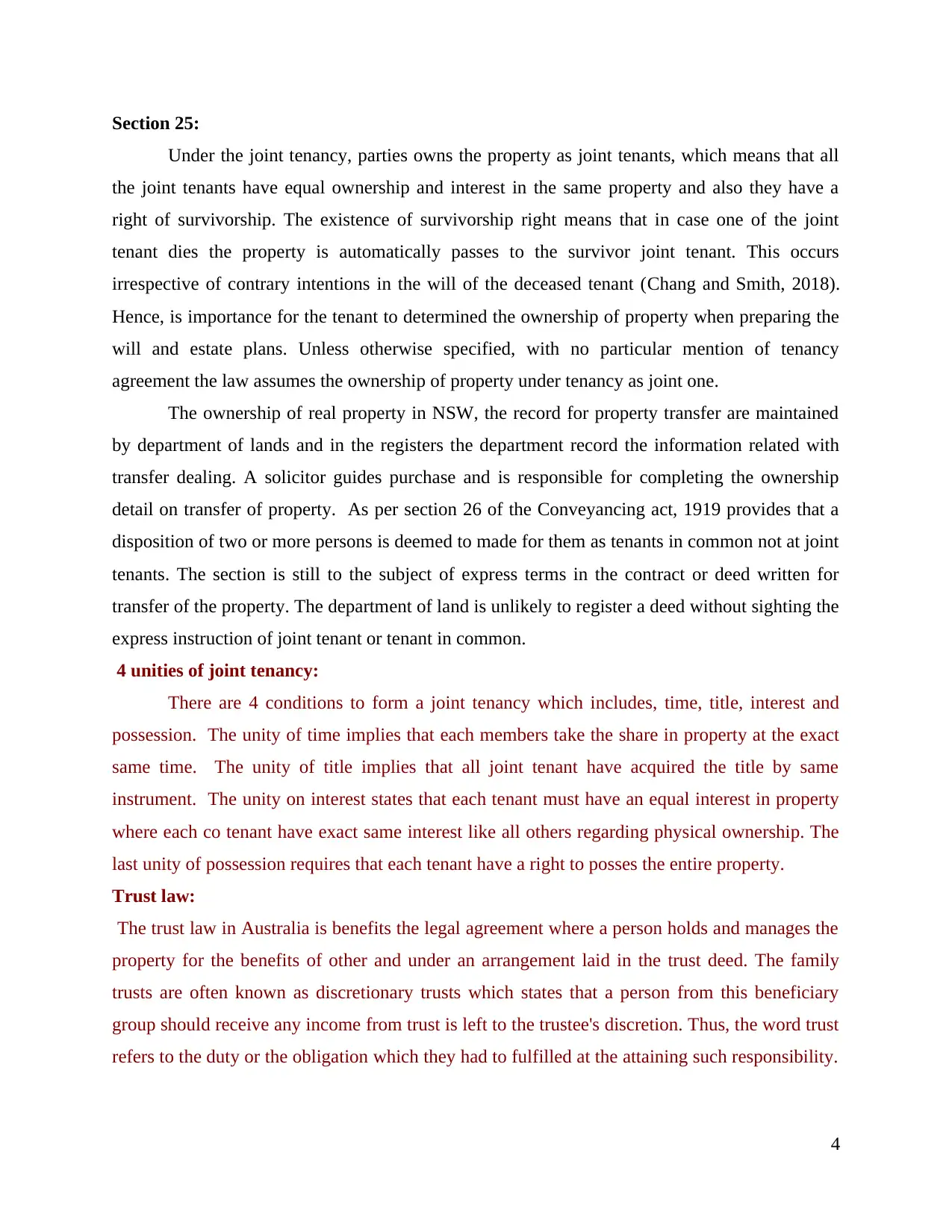
Section 25:
Under the joint tenancy, parties owns the property as joint tenants, which means that all
the joint tenants have equal ownership and interest in the same property and also they have a
right of survivorship. The existence of survivorship right means that in case one of the joint
tenant dies the property is automatically passes to the survivor joint tenant. This occurs
irrespective of contrary intentions in the will of the deceased tenant (Chang and Smith, 2018).
Hence, is importance for the tenant to determined the ownership of property when preparing the
will and estate plans. Unless otherwise specified, with no particular mention of tenancy
agreement the law assumes the ownership of property under tenancy as joint one.
The ownership of real property in NSW, the record for property transfer are maintained
by department of lands and in the registers the department record the information related with
transfer dealing. A solicitor guides purchase and is responsible for completing the ownership
detail on transfer of property. As per section 26 of the Conveyancing act, 1919 provides that a
disposition of two or more persons is deemed to made for them as tenants in common not at joint
tenants. The section is still to the subject of express terms in the contract or deed written for
transfer of the property. The department of land is unlikely to register a deed without sighting the
express instruction of joint tenant or tenant in common.
4 unities of joint tenancy:
There are 4 conditions to form a joint tenancy which includes, time, title, interest and
possession. The unity of time implies that each members take the share in property at the exact
same time. The unity of title implies that all joint tenant have acquired the title by same
instrument. The unity on interest states that each tenant must have an equal interest in property
where each co tenant have exact same interest like all others regarding physical ownership. The
last unity of possession requires that each tenant have a right to posses the entire property.
Trust law:
The trust law in Australia is benefits the legal agreement where a person holds and manages the
property for the benefits of other and under an arrangement laid in the trust deed. The family
trusts are often known as discretionary trusts which states that a person from this beneficiary
group should receive any income from trust is left to the trustee's discretion. Thus, the word trust
refers to the duty or the obligation which they had to fulfilled at the attaining such responsibility.
4
Under the joint tenancy, parties owns the property as joint tenants, which means that all
the joint tenants have equal ownership and interest in the same property and also they have a
right of survivorship. The existence of survivorship right means that in case one of the joint
tenant dies the property is automatically passes to the survivor joint tenant. This occurs
irrespective of contrary intentions in the will of the deceased tenant (Chang and Smith, 2018).
Hence, is importance for the tenant to determined the ownership of property when preparing the
will and estate plans. Unless otherwise specified, with no particular mention of tenancy
agreement the law assumes the ownership of property under tenancy as joint one.
The ownership of real property in NSW, the record for property transfer are maintained
by department of lands and in the registers the department record the information related with
transfer dealing. A solicitor guides purchase and is responsible for completing the ownership
detail on transfer of property. As per section 26 of the Conveyancing act, 1919 provides that a
disposition of two or more persons is deemed to made for them as tenants in common not at joint
tenants. The section is still to the subject of express terms in the contract or deed written for
transfer of the property. The department of land is unlikely to register a deed without sighting the
express instruction of joint tenant or tenant in common.
4 unities of joint tenancy:
There are 4 conditions to form a joint tenancy which includes, time, title, interest and
possession. The unity of time implies that each members take the share in property at the exact
same time. The unity of title implies that all joint tenant have acquired the title by same
instrument. The unity on interest states that each tenant must have an equal interest in property
where each co tenant have exact same interest like all others regarding physical ownership. The
last unity of possession requires that each tenant have a right to posses the entire property.
Trust law:
The trust law in Australia is benefits the legal agreement where a person holds and manages the
property for the benefits of other and under an arrangement laid in the trust deed. The family
trusts are often known as discretionary trusts which states that a person from this beneficiary
group should receive any income from trust is left to the trustee's discretion. Thus, the word trust
refers to the duty or the obligation which they had to fulfilled at the attaining such responsibility.
4
Paraphrase This Document
Need a fresh take? Get an instant paraphrase of this document with our AI Paraphraser
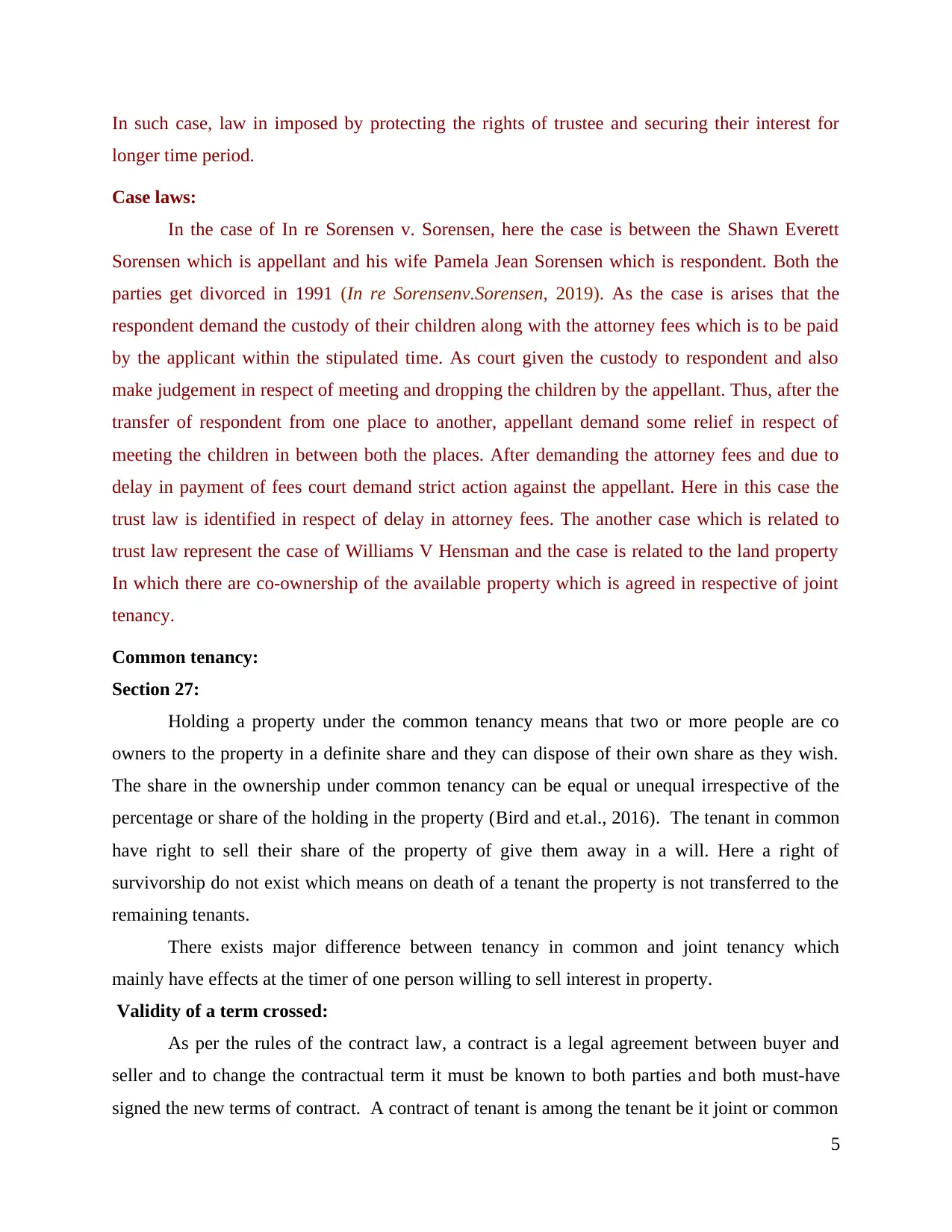
In such case, law in imposed by protecting the rights of trustee and securing their interest for
longer time period.
Case laws:
In the case of In re Sorensen v. Sorensen, here the case is between the Shawn Everett
Sorensen which is appellant and his wife Pamela Jean Sorensen which is respondent. Both the
parties get divorced in 1991 (In re Sorensenv.Sorensen, 2019). As the case is arises that the
respondent demand the custody of their children along with the attorney fees which is to be paid
by the applicant within the stipulated time. As court given the custody to respondent and also
make judgement in respect of meeting and dropping the children by the appellant. Thus, after the
transfer of respondent from one place to another, appellant demand some relief in respect of
meeting the children in between both the places. After demanding the attorney fees and due to
delay in payment of fees court demand strict action against the appellant. Here in this case the
trust law is identified in respect of delay in attorney fees. The another case which is related to
trust law represent the case of Williams V Hensman and the case is related to the land property
In which there are co-ownership of the available property which is agreed in respective of joint
tenancy.
Common tenancy:
Section 27:
Holding a property under the common tenancy means that two or more people are co
owners to the property in a definite share and they can dispose of their own share as they wish.
The share in the ownership under common tenancy can be equal or unequal irrespective of the
percentage or share of the holding in the property (Bird and et.al., 2016). The tenant in common
have right to sell their share of the property of give them away in a will. Here a right of
survivorship do not exist which means on death of a tenant the property is not transferred to the
remaining tenants.
There exists major difference between tenancy in common and joint tenancy which
mainly have effects at the timer of one person willing to sell interest in property.
Validity of a term crossed:
As per the rules of the contract law, a contract is a legal agreement between buyer and
seller and to change the contractual term it must be known to both parties and both must-have
signed the new terms of contract. A contract of tenant is among the tenant be it joint or common
5
longer time period.
Case laws:
In the case of In re Sorensen v. Sorensen, here the case is between the Shawn Everett
Sorensen which is appellant and his wife Pamela Jean Sorensen which is respondent. Both the
parties get divorced in 1991 (In re Sorensenv.Sorensen, 2019). As the case is arises that the
respondent demand the custody of their children along with the attorney fees which is to be paid
by the applicant within the stipulated time. As court given the custody to respondent and also
make judgement in respect of meeting and dropping the children by the appellant. Thus, after the
transfer of respondent from one place to another, appellant demand some relief in respect of
meeting the children in between both the places. After demanding the attorney fees and due to
delay in payment of fees court demand strict action against the appellant. Here in this case the
trust law is identified in respect of delay in attorney fees. The another case which is related to
trust law represent the case of Williams V Hensman and the case is related to the land property
In which there are co-ownership of the available property which is agreed in respective of joint
tenancy.
Common tenancy:
Section 27:
Holding a property under the common tenancy means that two or more people are co
owners to the property in a definite share and they can dispose of their own share as they wish.
The share in the ownership under common tenancy can be equal or unequal irrespective of the
percentage or share of the holding in the property (Bird and et.al., 2016). The tenant in common
have right to sell their share of the property of give them away in a will. Here a right of
survivorship do not exist which means on death of a tenant the property is not transferred to the
remaining tenants.
There exists major difference between tenancy in common and joint tenancy which
mainly have effects at the timer of one person willing to sell interest in property.
Validity of a term crossed:
As per the rules of the contract law, a contract is a legal agreement between buyer and
seller and to change the contractual term it must be known to both parties and both must-have
signed the new terms of contract. A contract of tenant is among the tenant be it joint or common
5
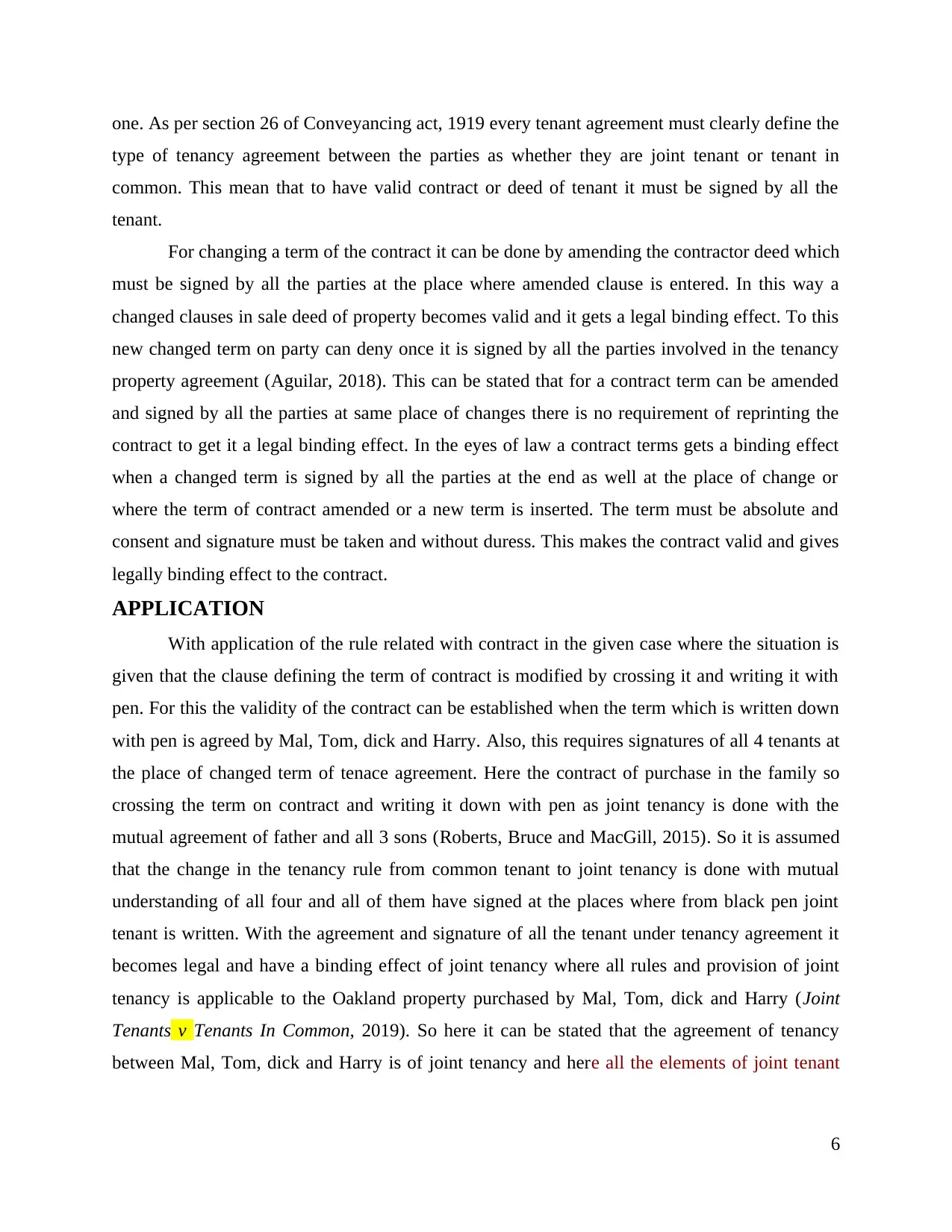
one. As per section 26 of Conveyancing act, 1919 every tenant agreement must clearly define the
type of tenancy agreement between the parties as whether they are joint tenant or tenant in
common. This mean that to have valid contract or deed of tenant it must be signed by all the
tenant.
For changing a term of the contract it can be done by amending the contractor deed which
must be signed by all the parties at the place where amended clause is entered. In this way a
changed clauses in sale deed of property becomes valid and it gets a legal binding effect. To this
new changed term on party can deny once it is signed by all the parties involved in the tenancy
property agreement (Aguilar, 2018). This can be stated that for a contract term can be amended
and signed by all the parties at same place of changes there is no requirement of reprinting the
contract to get it a legal binding effect. In the eyes of law a contract terms gets a binding effect
when a changed term is signed by all the parties at the end as well at the place of change or
where the term of contract amended or a new term is inserted. The term must be absolute and
consent and signature must be taken and without duress. This makes the contract valid and gives
legally binding effect to the contract.
APPLICATION
With application of the rule related with contract in the given case where the situation is
given that the clause defining the term of contract is modified by crossing it and writing it with
pen. For this the validity of the contract can be established when the term which is written down
with pen is agreed by Mal, Tom, dick and Harry. Also, this requires signatures of all 4 tenants at
the place of changed term of tenace agreement. Here the contract of purchase in the family so
crossing the term on contract and writing it down with pen as joint tenancy is done with the
mutual agreement of father and all 3 sons (Roberts, Bruce and MacGill, 2015). So it is assumed
that the change in the tenancy rule from common tenant to joint tenancy is done with mutual
understanding of all four and all of them have signed at the places where from black pen joint
tenant is written. With the agreement and signature of all the tenant under tenancy agreement it
becomes legal and have a binding effect of joint tenancy where all rules and provision of joint
tenancy is applicable to the Oakland property purchased by Mal, Tom, dick and Harry (Joint
Tenants v Tenants In Common, 2019). So here it can be stated that the agreement of tenancy
between Mal, Tom, dick and Harry is of joint tenancy and here all the elements of joint tenant
6
type of tenancy agreement between the parties as whether they are joint tenant or tenant in
common. This mean that to have valid contract or deed of tenant it must be signed by all the
tenant.
For changing a term of the contract it can be done by amending the contractor deed which
must be signed by all the parties at the place where amended clause is entered. In this way a
changed clauses in sale deed of property becomes valid and it gets a legal binding effect. To this
new changed term on party can deny once it is signed by all the parties involved in the tenancy
property agreement (Aguilar, 2018). This can be stated that for a contract term can be amended
and signed by all the parties at same place of changes there is no requirement of reprinting the
contract to get it a legal binding effect. In the eyes of law a contract terms gets a binding effect
when a changed term is signed by all the parties at the end as well at the place of change or
where the term of contract amended or a new term is inserted. The term must be absolute and
consent and signature must be taken and without duress. This makes the contract valid and gives
legally binding effect to the contract.
APPLICATION
With application of the rule related with contract in the given case where the situation is
given that the clause defining the term of contract is modified by crossing it and writing it with
pen. For this the validity of the contract can be established when the term which is written down
with pen is agreed by Mal, Tom, dick and Harry. Also, this requires signatures of all 4 tenants at
the place of changed term of tenace agreement. Here the contract of purchase in the family so
crossing the term on contract and writing it down with pen as joint tenancy is done with the
mutual agreement of father and all 3 sons (Roberts, Bruce and MacGill, 2015). So it is assumed
that the change in the tenancy rule from common tenant to joint tenancy is done with mutual
understanding of all four and all of them have signed at the places where from black pen joint
tenant is written. With the agreement and signature of all the tenant under tenancy agreement it
becomes legal and have a binding effect of joint tenancy where all rules and provision of joint
tenancy is applicable to the Oakland property purchased by Mal, Tom, dick and Harry (Joint
Tenants v Tenants In Common, 2019). So here it can be stated that the agreement of tenancy
between Mal, Tom, dick and Harry is of joint tenancy and here all the elements of joint tenant
6
⊘ This is a preview!⊘
Do you want full access?
Subscribe today to unlock all pages.

Trusted by 1+ million students worldwide
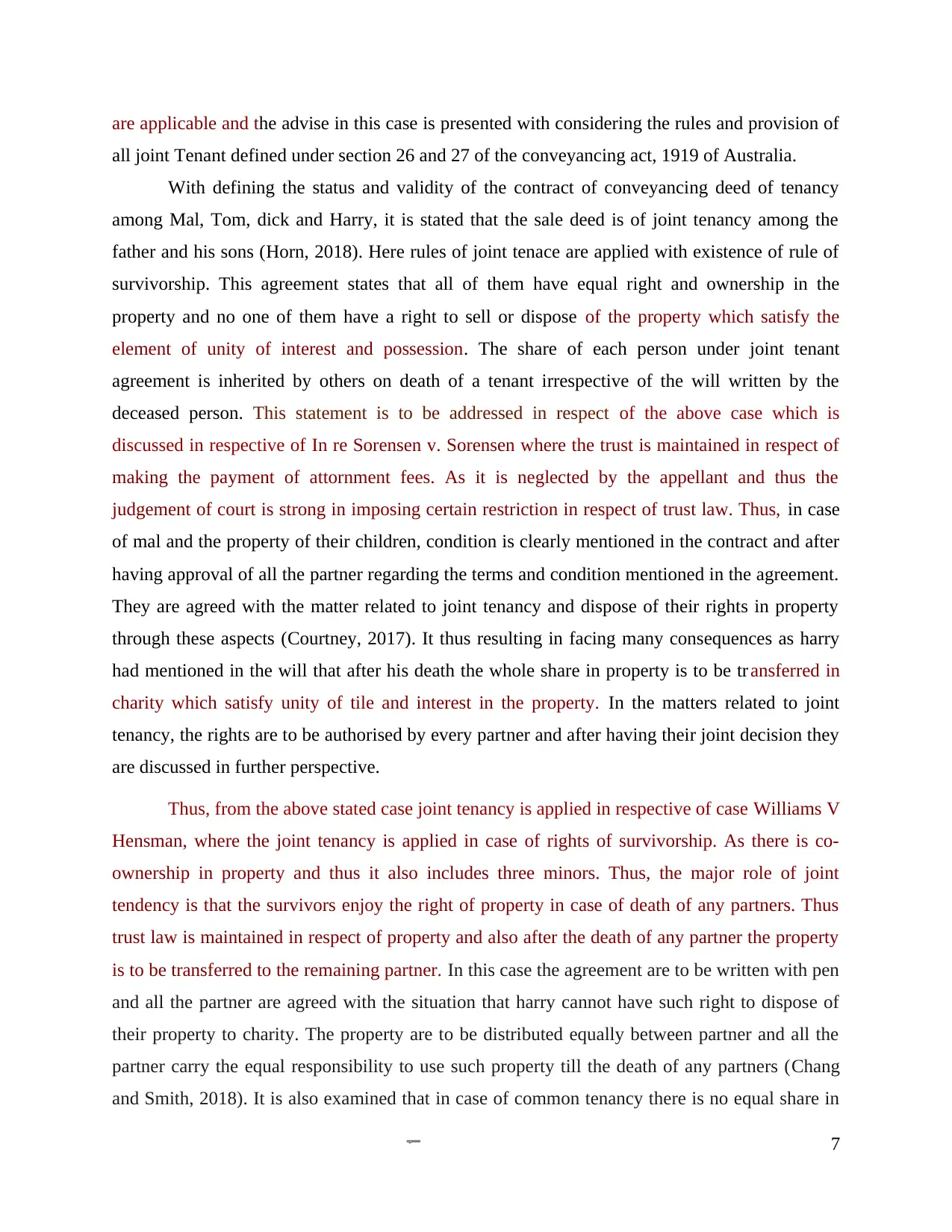
are applicable and the advise in this case is presented with considering the rules and provision of
all joint Tenant defined under section 26 and 27 of the conveyancing act, 1919 of Australia.
With defining the status and validity of the contract of conveyancing deed of tenancy
among Mal, Tom, dick and Harry, it is stated that the sale deed is of joint tenancy among the
father and his sons (Horn, 2018). Here rules of joint tenace are applied with existence of rule of
survivorship. This agreement states that all of them have equal right and ownership in the
property and no one of them have a right to sell or dispose of the property which satisfy the
element of unity of interest and possession. The share of each person under joint tenant
agreement is inherited by others on death of a tenant irrespective of the will written by the
deceased person. This statement is to be addressed in respect of the above case which is
discussed in respective of In re Sorensen v. Sorensen where the trust is maintained in respect of
making the payment of attornment fees. As it is neglected by the appellant and thus the
judgement of court is strong in imposing certain restriction in respect of trust law. Thus, in case
of mal and the property of their children, condition is clearly mentioned in the contract and after
having approval of all the partner regarding the terms and condition mentioned in the agreement.
They are agreed with the matter related to joint tenancy and dispose of their rights in property
through these aspects (Courtney, 2017). It thus resulting in facing many consequences as harry
had mentioned in the will that after his death the whole share in property is to be tr ansferred in
charity which satisfy unity of tile and interest in the property. In the matters related to joint
tenancy, the rights are to be authorised by every partner and after having their joint decision they
are discussed in further perspective.
Thus, from the above stated case joint tenancy is applied in respective of case Williams V
Hensman, where the joint tenancy is applied in case of rights of survivorship. As there is co-
ownership in property and thus it also includes three minors. Thus, the major role of joint
tendency is that the survivors enjoy the right of property in case of death of any partners. Thus
trust law is maintained in respect of property and also after the death of any partner the property
is to be transferred to the remaining partner. In this case the agreement are to be written with pen
and all the partner are agreed with the situation that harry cannot have such right to dispose of
their property to charity. The property are to be distributed equally between partner and all the
partner carry the equal responsibility to use such property till the death of any partners (Chang
and Smith, 2018). It is also examined that in case of common tenancy there is no equal share in
7
all joint Tenant defined under section 26 and 27 of the conveyancing act, 1919 of Australia.
With defining the status and validity of the contract of conveyancing deed of tenancy
among Mal, Tom, dick and Harry, it is stated that the sale deed is of joint tenancy among the
father and his sons (Horn, 2018). Here rules of joint tenace are applied with existence of rule of
survivorship. This agreement states that all of them have equal right and ownership in the
property and no one of them have a right to sell or dispose of the property which satisfy the
element of unity of interest and possession. The share of each person under joint tenant
agreement is inherited by others on death of a tenant irrespective of the will written by the
deceased person. This statement is to be addressed in respect of the above case which is
discussed in respective of In re Sorensen v. Sorensen where the trust is maintained in respect of
making the payment of attornment fees. As it is neglected by the appellant and thus the
judgement of court is strong in imposing certain restriction in respect of trust law. Thus, in case
of mal and the property of their children, condition is clearly mentioned in the contract and after
having approval of all the partner regarding the terms and condition mentioned in the agreement.
They are agreed with the matter related to joint tenancy and dispose of their rights in property
through these aspects (Courtney, 2017). It thus resulting in facing many consequences as harry
had mentioned in the will that after his death the whole share in property is to be tr ansferred in
charity which satisfy unity of tile and interest in the property. In the matters related to joint
tenancy, the rights are to be authorised by every partner and after having their joint decision they
are discussed in further perspective.
Thus, from the above stated case joint tenancy is applied in respective of case Williams V
Hensman, where the joint tenancy is applied in case of rights of survivorship. As there is co-
ownership in property and thus it also includes three minors. Thus, the major role of joint
tendency is that the survivors enjoy the right of property in case of death of any partners. Thus
trust law is maintained in respect of property and also after the death of any partner the property
is to be transferred to the remaining partner. In this case the agreement are to be written with pen
and all the partner are agreed with the situation that harry cannot have such right to dispose of
their property to charity. The property are to be distributed equally between partner and all the
partner carry the equal responsibility to use such property till the death of any partners (Chang
and Smith, 2018). It is also examined that in case of common tenancy there is no equal share in
7
Paraphrase This Document
Need a fresh take? Get an instant paraphrase of this document with our AI Paraphraser
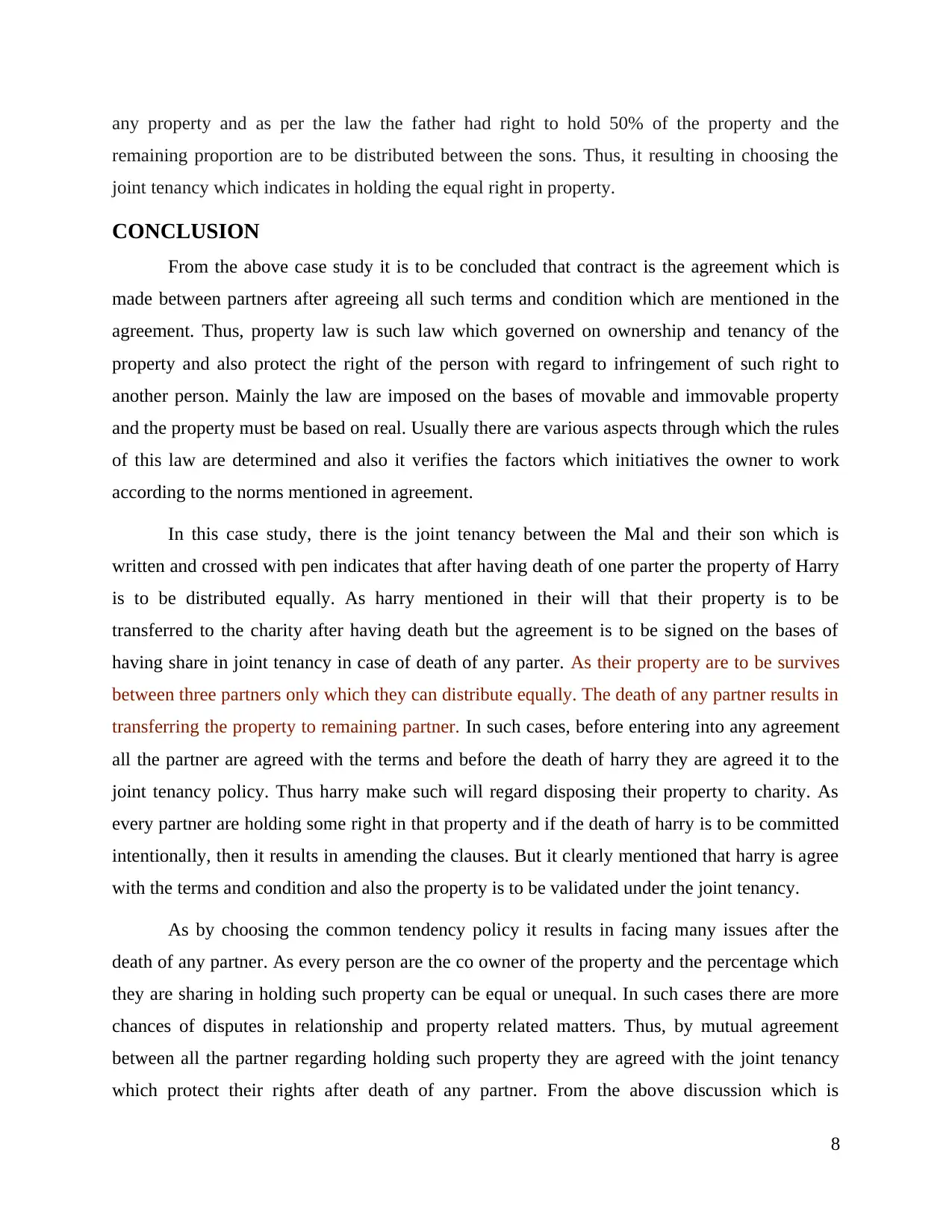
any property and as per the law the father had right to hold 50% of the property and the
remaining proportion are to be distributed between the sons. Thus, it resulting in choosing the
joint tenancy which indicates in holding the equal right in property.
CONCLUSION
From the above case study it is to be concluded that contract is the agreement which is
made between partners after agreeing all such terms and condition which are mentioned in the
agreement. Thus, property law is such law which governed on ownership and tenancy of the
property and also protect the right of the person with regard to infringement of such right to
another person. Mainly the law are imposed on the bases of movable and immovable property
and the property must be based on real. Usually there are various aspects through which the rules
of this law are determined and also it verifies the factors which initiatives the owner to work
according to the norms mentioned in agreement.
In this case study, there is the joint tenancy between the Mal and their son which is
written and crossed with pen indicates that after having death of one parter the property of Harry
is to be distributed equally. As harry mentioned in their will that their property is to be
transferred to the charity after having death but the agreement is to be signed on the bases of
having share in joint tenancy in case of death of any parter. As their property are to be survives
between three partners only which they can distribute equally. The death of any partner results in
transferring the property to remaining partner. In such cases, before entering into any agreement
all the partner are agreed with the terms and before the death of harry they are agreed it to the
joint tenancy policy. Thus harry make such will regard disposing their property to charity. As
every partner are holding some right in that property and if the death of harry is to be committed
intentionally, then it results in amending the clauses. But it clearly mentioned that harry is agree
with the terms and condition and also the property is to be validated under the joint tenancy.
As by choosing the common tendency policy it results in facing many issues after the
death of any partner. As every person are the co owner of the property and the percentage which
they are sharing in holding such property can be equal or unequal. In such cases there are more
chances of disputes in relationship and property related matters. Thus, by mutual agreement
between all the partner regarding holding such property they are agreed with the joint tenancy
which protect their rights after death of any partner. From the above discussion which is
8
remaining proportion are to be distributed between the sons. Thus, it resulting in choosing the
joint tenancy which indicates in holding the equal right in property.
CONCLUSION
From the above case study it is to be concluded that contract is the agreement which is
made between partners after agreeing all such terms and condition which are mentioned in the
agreement. Thus, property law is such law which governed on ownership and tenancy of the
property and also protect the right of the person with regard to infringement of such right to
another person. Mainly the law are imposed on the bases of movable and immovable property
and the property must be based on real. Usually there are various aspects through which the rules
of this law are determined and also it verifies the factors which initiatives the owner to work
according to the norms mentioned in agreement.
In this case study, there is the joint tenancy between the Mal and their son which is
written and crossed with pen indicates that after having death of one parter the property of Harry
is to be distributed equally. As harry mentioned in their will that their property is to be
transferred to the charity after having death but the agreement is to be signed on the bases of
having share in joint tenancy in case of death of any parter. As their property are to be survives
between three partners only which they can distribute equally. The death of any partner results in
transferring the property to remaining partner. In such cases, before entering into any agreement
all the partner are agreed with the terms and before the death of harry they are agreed it to the
joint tenancy policy. Thus harry make such will regard disposing their property to charity. As
every partner are holding some right in that property and if the death of harry is to be committed
intentionally, then it results in amending the clauses. But it clearly mentioned that harry is agree
with the terms and condition and also the property is to be validated under the joint tenancy.
As by choosing the common tendency policy it results in facing many issues after the
death of any partner. As every person are the co owner of the property and the percentage which
they are sharing in holding such property can be equal or unequal. In such cases there are more
chances of disputes in relationship and property related matters. Thus, by mutual agreement
between all the partner regarding holding such property they are agreed with the joint tenancy
which protect their rights after death of any partner. From the above discussion which is
8
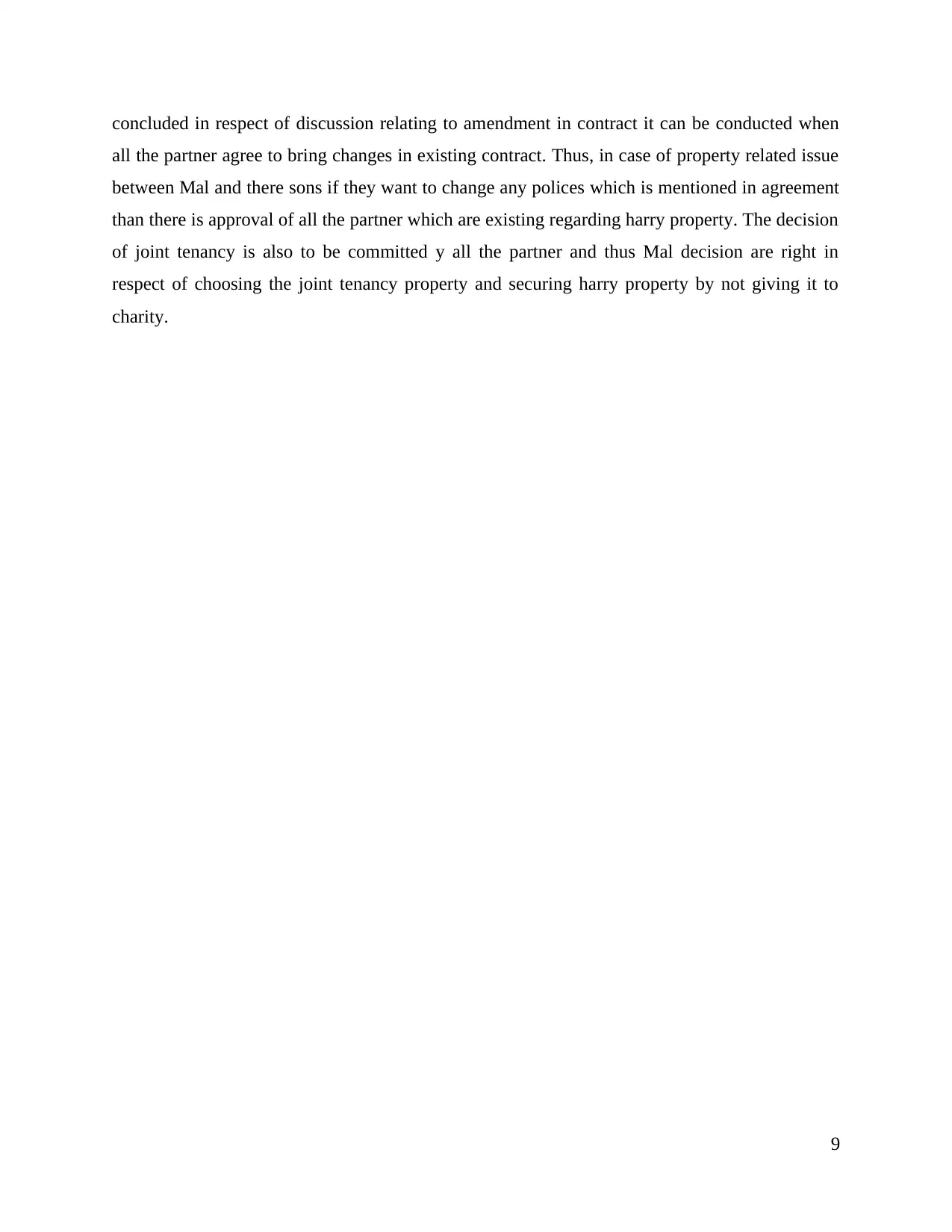
concluded in respect of discussion relating to amendment in contract it can be conducted when
all the partner agree to bring changes in existing contract. Thus, in case of property related issue
between Mal and there sons if they want to change any polices which is mentioned in agreement
than there is approval of all the partner which are existing regarding harry property. The decision
of joint tenancy is also to be committed y all the partner and thus Mal decision are right in
respect of choosing the joint tenancy property and securing harry property by not giving it to
charity.
9
all the partner agree to bring changes in existing contract. Thus, in case of property related issue
between Mal and there sons if they want to change any polices which is mentioned in agreement
than there is approval of all the partner which are existing regarding harry property. The decision
of joint tenancy is also to be committed y all the partner and thus Mal decision are right in
respect of choosing the joint tenancy property and securing harry property by not giving it to
charity.
9
⊘ This is a preview!⊘
Do you want full access?
Subscribe today to unlock all pages.

Trusted by 1+ million students worldwide
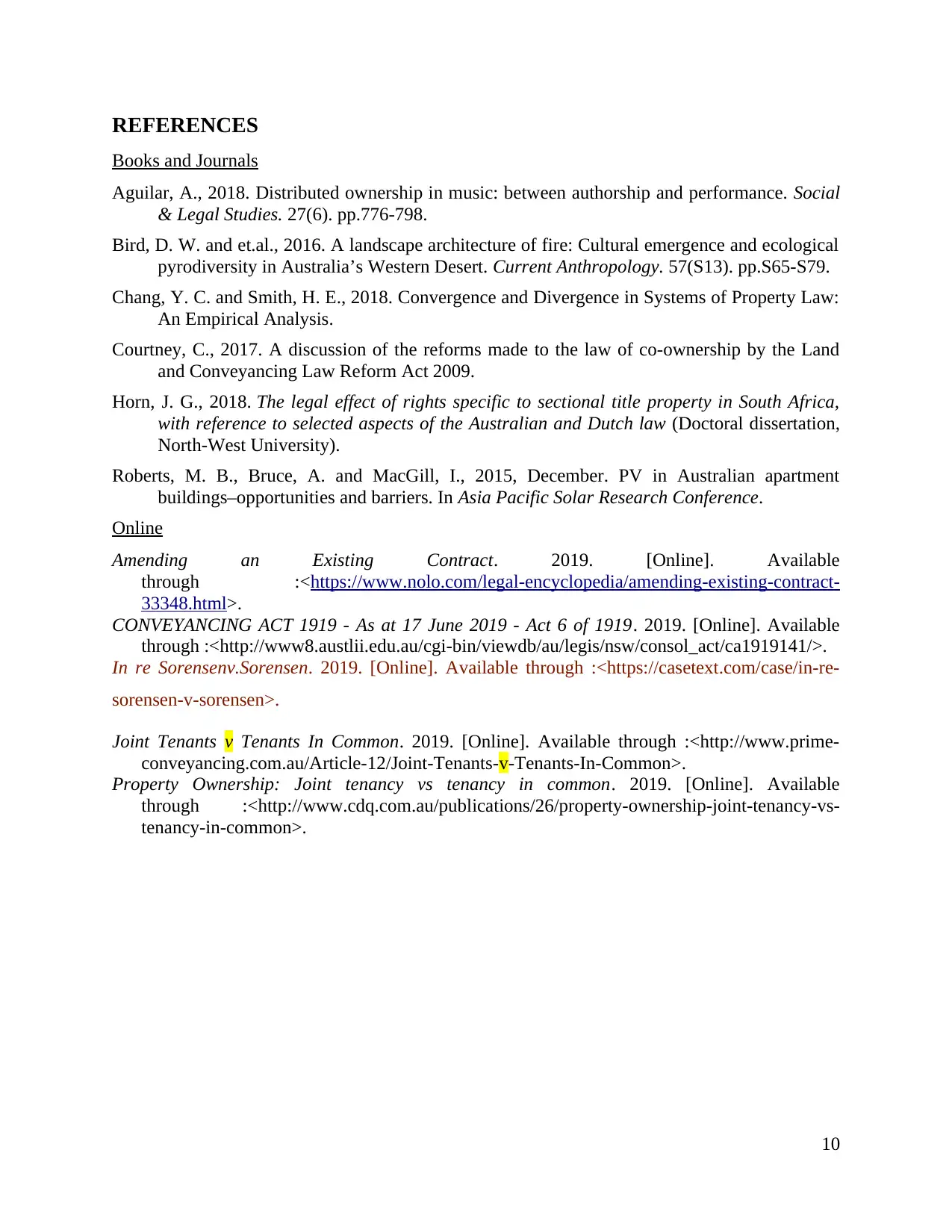
REFERENCES
Books and Journals
Aguilar, A., 2018. Distributed ownership in music: between authorship and performance. Social
& Legal Studies. 27(6). pp.776-798.
Bird, D. W. and et.al., 2016. A landscape architecture of fire: Cultural emergence and ecological
pyrodiversity in Australia’s Western Desert. Current Anthropology. 57(S13). pp.S65-S79.
Chang, Y. C. and Smith, H. E., 2018. Convergence and Divergence in Systems of Property Law:
An Empirical Analysis.
Courtney, C., 2017. A discussion of the reforms made to the law of co-ownership by the Land
and Conveyancing Law Reform Act 2009.
Horn, J. G., 2018. The legal effect of rights specific to sectional title property in South Africa,
with reference to selected aspects of the Australian and Dutch law (Doctoral dissertation,
North-West University).
Roberts, M. B., Bruce, A. and MacGill, I., 2015, December. PV in Australian apartment
buildings–opportunities and barriers. In Asia Pacific Solar Research Conference.
Online
Amending an Existing Contract. 2019. [Online]. Available
through :<https://www.nolo.com/legal-encyclopedia/amending-existing-contract-
33348.html>.
CONVEYANCING ACT 1919 - As at 17 June 2019 - Act 6 of 1919. 2019. [Online]. Available
through :<http://www8.austlii.edu.au/cgi-bin/viewdb/au/legis/nsw/consol_act/ca1919141/>.
In re Sorensenv.Sorensen. 2019. [Online]. Available through :<https://casetext.com/case/in-re-
sorensen-v-sorensen>.
Joint Tenants v Tenants In Common. 2019. [Online]. Available through :<http://www.prime-
conveyancing.com.au/Article-12/Joint-Tenants-v-Tenants-In-Common>.
Property Ownership: Joint tenancy vs tenancy in common. 2019. [Online]. Available
through :<http://www.cdq.com.au/publications/26/property-ownership-joint-tenancy-vs-
tenancy-in-common>.
10
Books and Journals
Aguilar, A., 2018. Distributed ownership in music: between authorship and performance. Social
& Legal Studies. 27(6). pp.776-798.
Bird, D. W. and et.al., 2016. A landscape architecture of fire: Cultural emergence and ecological
pyrodiversity in Australia’s Western Desert. Current Anthropology. 57(S13). pp.S65-S79.
Chang, Y. C. and Smith, H. E., 2018. Convergence and Divergence in Systems of Property Law:
An Empirical Analysis.
Courtney, C., 2017. A discussion of the reforms made to the law of co-ownership by the Land
and Conveyancing Law Reform Act 2009.
Horn, J. G., 2018. The legal effect of rights specific to sectional title property in South Africa,
with reference to selected aspects of the Australian and Dutch law (Doctoral dissertation,
North-West University).
Roberts, M. B., Bruce, A. and MacGill, I., 2015, December. PV in Australian apartment
buildings–opportunities and barriers. In Asia Pacific Solar Research Conference.
Online
Amending an Existing Contract. 2019. [Online]. Available
through :<https://www.nolo.com/legal-encyclopedia/amending-existing-contract-
33348.html>.
CONVEYANCING ACT 1919 - As at 17 June 2019 - Act 6 of 1919. 2019. [Online]. Available
through :<http://www8.austlii.edu.au/cgi-bin/viewdb/au/legis/nsw/consol_act/ca1919141/>.
In re Sorensenv.Sorensen. 2019. [Online]. Available through :<https://casetext.com/case/in-re-
sorensen-v-sorensen>.
Joint Tenants v Tenants In Common. 2019. [Online]. Available through :<http://www.prime-
conveyancing.com.au/Article-12/Joint-Tenants-v-Tenants-In-Common>.
Property Ownership: Joint tenancy vs tenancy in common. 2019. [Online]. Available
through :<http://www.cdq.com.au/publications/26/property-ownership-joint-tenancy-vs-
tenancy-in-common>.
10
1 out of 10
Related Documents
Your All-in-One AI-Powered Toolkit for Academic Success.
+13062052269
info@desklib.com
Available 24*7 on WhatsApp / Email
![[object Object]](/_next/static/media/star-bottom.7253800d.svg)
Unlock your academic potential
Copyright © 2020–2025 A2Z Services. All Rights Reserved. Developed and managed by ZUCOL.





